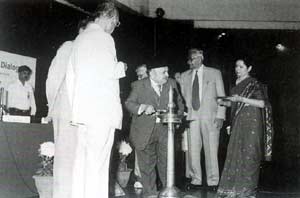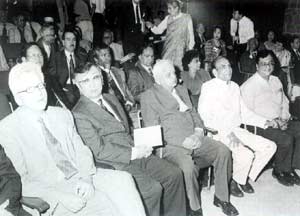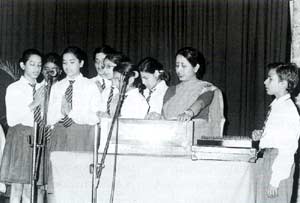


All religion prayer being rendered by school children
Asian Civilizational DialogueAsia the cradle of several ancient civilization. This geographic region shares a commonality in its multiplicity of cultures. The collective strength of Asian civilizations is yet to be realized. With the basic objective of initiating a meaningful communication between the people of Asia – between cultures and between civilizations the IGNCA hosted the first International Conference on ‘Asian Civilizational Dialogue’ on March 9. 10 and 11, 2004. People representing almost all the countries in Asia participated in the Dialogue. the conference 2was inaugurated by the then Union Tourism and Culture Minister Shri Jagmohan. The President of India, Shri A.P.J. Abdul Kalam in his message to the participants said “the time has come for building bridges of international dialogue and understanding. Asian countries could make a stat as they have a common cultural, spiritual and social perception of man and the universe.” The director General of UNESCO Shri Kochio Mastusuura sent a message on this occasion, which was read by Toufik at the inauguration. Shri Mastsurra, applauding the initiative, suggested to the participants to follow the resolution of the 32nd Session of the General Conference of UNESCO which was based on the resolution of the Inter-ministerial Conference on ‘Dialogue Among Civilizations’, held in New Delhi last July. The then Foreign Minister of India Shri Yashwant Sinha also sent his message of goodwill for the conference. Dr. L.M. Singhvi, President, IGNCA Trust and Chairman of ‘Asian Civilizational Dialogue’ said the dialogue was Asia-centric. He said the Conference was not an isolated event. It would be sustained and enlarged to be Asia-Africa and Asia-Europe dialogue, he added. “with this I hope Asia will no more be marginalized, her voice will be head” Dr. Singhvi said. he stressed on the need to approach the Dialogue with an open mind and a fee, unprejudiced heart. The Sasakawa Peace Foundation of Japan, India International Centre, and the Indian Council for Cultural Relations co-hosted the conference. Dr. K.C. Chakravarty, Member Secretary, IGNCA, in his address said there was need for combative action for shoring up defences all over Asia against the reduction of all sacred and ecological categories into production and economic categories. He also called for collaboration among nations to strengthen syncretic traditions as also Prof. Indra Nath Choudhuri, Academic Director, IGNCA said “one of the important aspects of dialogue is to know each other, each other’s culture and also their creativity and meditative thought.” He spoke about the Asian confluences and convergences of poetry, philosophy and aesthetics, particularly with reference to India, China and Japan. Prof. Daisaburo Hashizume of the Sasakawa Foundation and the Co-chairman of the Asian Civilizational Dialogue in his address said “our identity is linked to our way of thinking. We are all afraid of thinking differently because we are afraid of losing our identity.” A dialogue among the mankind therefore was difficult. He suggested that the cultural similarities in civilizations were the appropriate basis for a dialogue. Dr. Najma Heptullah, the then Charperson, Rajya Sabha, said that Asia was the land where all great religions of the world originated. India, the mainspring of great thought and culture had been a bridge between the West and East Asia. She said that this dialogue among Asian civilizations should be in terms of the present and future and not in terms of the past. Dr. Murli Manohar Joshi, the then Union Minister for Human Resources Development, spoke about celebrating the post-Cartesion world of identity in difference, of indiscriminacy and interconnectedness. He stressed that the search in art and culture, in civilizational dialogue should be, as in science for integration rather than fragmentation and differentiation. The participants came from Japan, Myanmar, Indonesia, China, Vietnam, Sri Lanka, Thailand, India, and Pakistan. On the second day, world-renowned violinist Dr. L. Subramanyam gave a concert to mark the occasion. Dr. Srikrishna Yada, from Nepal, in his paper on ‘Nepal and its neighbours in Asian Civilizational Dialogue a perspective of past, present and future’ said that the path hewn by our sages that “learning from each other is possible” was the right way to a harmonious living and should from the basis of civilizational dialogue. Dr. Ven Thich Tam Due of Vietnam speaking on ‘Vietnamese contribution to Asian Civilization, retrospect and prospect’ said if the 20th century was dominated by the western civilization, the late 20 and 21st century had put the Asian civilizations on the vanguard. He said that Vietnam’s deeply Buddhist philosophy had helped it sustain the various struggles the country faced. This philosophy believed in peaceful co-existence. Dr. Tilokasundari Kariyawasam, from Sri Lanka, in her paper on ‘Buddhism in Asian Civilizational Dialogue’ said that Buddhism ahd contributed immensely to the Asian civilization. Though Buddha was born in India, his preaching has had a lasting impact on the people of Sri Lank, Thailand, Cambodia, Myanmar, Lao, Nepal, Mongolia, Korea, Japan, Vietnam, Tibet, China and Taiwan. “The transforming nature of Buddhism has changed people, men and women, kings and peasants and thus nations,” she said.
Justice (retd) J.S. Verma said in his paper ‘Human rights and human responsibilities in the contemporary discourse of Asian civilizations’ that a true synthesis of the eastern concept of human rights and responsibilities coupled with its honest practice by every member of human family alone could ensure realization of a peaceful coexistence.
Dr. Lokesh Chandra in his paper on ‘Polycentrism as the core of inter-Asian Dialogue’ said “the emergence of world without frontiers will have to avoid the historical misfortune of a tortured image of regimentation. Cultures have to remain “timeless moments” elusive dreama, unhemmed by space, eternal wanderers in search of the meaning of existence.” ‘The Civilization of Mud: Mud, the origin of life’ by Kenichi Matsumoto, from Japan said that the civilization of mud was established on the reality that mud gave birth to many form of life. Human beings were also born from mud. He connected the life on earth to water, mud and light (sun) and cited them as common features that could unite civilizations. ‘China and the Asian civilizational dialogue’ by Wang Ping (China) felt that the oriental culture and values of peace, tolerance and co-existence should form the basis for civilizational dialogues. Dr. Bahiya Aljishi, from the Kingdom of Bahrain, in hrter paper on ‘The role of women in the dialogue among civilizations’ emphasized that “no society can be based on principles of equal opportunities and justice without respecting the role of women in human development. Their role is imperative in the ongoing dialogue (among civilizations) to shape a new world order.” Kireet Joshi, speaking on ‘A dialogue on human consciousness and unity’ said, “the most important point in the dialogue of human consciousness and unity is to stress the true nature of spirituality. Spirituality points to something that is beyond the world, a reality that is transcendental, a reality that is so much emphasized in all universal religions which have sprung from Asia. The greatest need of Asia is to discover and manifest the treasure of its spiritual experience and put it at the disposal of itself and the humanity at large.” Prof. S.R. Bhatt, speaking on ‘Asian confluences and encounters: Realities and resonances of values’ said, “it is high time that we now have direct cultural understanding throwing off glasses of occidental Indologists.” A renewal of cross-cultural interactions would not only help mutual understanding, trust, empathy and enrichment, it would also consolidate and vitalize the common spiritual rot and resources, he said. Prof. S.M.A. Faiz, (Bangladesh) said that the civilizational dialogue had more importance now, in the era of globalization, where cross-cultural exchanges were taking place in the context of economics, finance and technology. The need of the hour was to preserve and commemorate the cultural diversity, he said. Hu Yeping, in his paper ‘Learning how to relate’ said “culture focuses upon the creative spirit of people and their ability to work together to build all dimensions of life.” For that reason, he said civilizations survive political, social economic and even ideological unheavals. In this global age, no man or people or civilization was an island, he added. Hassan Hanafi Hassanien, Egypt, in his paper ‘A dialogue of cultures and civilizations in Asia’ said “dialogue of cultures and civilizations in Asia is not merely theoretical and academic, related to the past, but it is also relevant to modern times. Clash of civilizations is alien to Asia. Dialogue of cultures expresses it unity of perception in spite of some limitations in historical legacy.” ‘Purpose and potentials of Indo-Pak people to people dialogue’ was the topic of Justice Dr. Nasim Hasan Shah, from Pakistan who suggested that there should be frequent and mutual contact between the people of the two countries. he also said people to people dialogue between the two countries should be promoted, especially involving the non-governmental institutions. [ Newsletter | List of Newsletter ]
|




